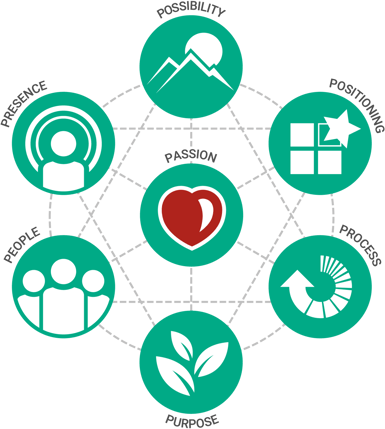What Your Lunch and Growth Strategy Have In Common
What does your day-to-day decision making process look like? You might consider how the options you’re weighing align with your personal values, your vision for yourself, and your role in your family, community, or workplace.
You may consciously apply this methodology to important decisions such as determining the next step in your career, or you may subconsciously churn through some of these components as you make a quick decision about what to have for lunch. Say you opt for the vegetarian plate with a plain iced tea at the local sandwich shop. While you may not have consciously thought through it, you made this selection because you were looking for a healthy and filling option that would support a local business and have a minimal impact on the environment. You may have not even realized it, but you’ve tapped into your Passion, Purpose, and Possibility to make your lunch decision.
Passion, Purpose, and Possibility form the backbone of Plenty’s Meridian strategy model and extend well beyond your lunch. These concepts can be used for value-driven decision making at all levels for individuals and organizations. Passion sits at the core of the strategy model as our passions and values drive all other aspects of ourselves and our organizations. Purpose outlines our mission and core reason for being, and Possibility is our vision for change.
 The core of this model, in conjunction with the other four supporting pillars, allows us to act and create change from a place of authenticity that is directly relevant to ourselves and our organizations at every step and decision along the way. At times, strategy can feel like a distant framework that is inaccessible to your short- and even mid-term decisions. Through the Meridian model, however, you’re not only able to make large, critical organizational decisions, but you’re also able to take action. Explore the other four pillars below to see how the Meridian model shows up in your organization already and how you can use the model for short- and long-term decision making.
The core of this model, in conjunction with the other four supporting pillars, allows us to act and create change from a place of authenticity that is directly relevant to ourselves and our organizations at every step and decision along the way. At times, strategy can feel like a distant framework that is inaccessible to your short- and even mid-term decisions. Through the Meridian model, however, you’re not only able to make large, critical organizational decisions, but you’re also able to take action. Explore the other four pillars below to see how the Meridian model shows up in your organization already and how you can use the model for short- and long-term decision making.
We start the conversation around organizational strategy and individual development with Passion, Purpose, and Possibility, but we can only begin here because these concepts are supported at a day-to-day, operational level by Process. Process is how we ground and implement all the other pillars and is often inherently a key aspect of many of our days. Ultimately, Process can help translate your high level strategy into your day-to-day actions.
Positioning, which is less tactical than process, is the strategy behind what makes your organization unique. At a high level, this is how your organization differentiates itself and leverages its uniqueness. At an operational level, Positioning can be used to focus your resources, such as time and bandwidth, on pursuits, conversations, and research that embodies your uniqueness and the specific audience that you serve. For example, in a business development context, you might focus outreach efforts specifically on leads that fall within your target audience and area of expertise. You can also use everyday conversations as an opportunity to reinforce your Positioning with your team, clients, and constituents to become ubiquitously known as the “go-to” organization for your area of specialization.
Once your Positioning is in place you can focus on Presence, which is how you want people to feel and think when they interact with you and your organization. Day-to-day, this might take the form of design, strategy, and content decisions that demonstrate who you are and why. Presence not only has a role on your website and in your outgoing communications, but also around the conference table, on the phone, and in your organization's culture. Presence is not a facade for your clients and constituents; it’s who you are as an organization inside and out. It’s tempting to try to be everything to everyone, but you can have a much greater impact when you’re authentically and wholly yourself to the people who need you.
Which leads us to the last, but definitely not least pillar, People. People represents your team(s) and who you work with — these are the individuals that embody your values and collectively work to help you reach your Possibility. At a high level, the People pillar comes into play in hiring decisions and determining who to work with. Day-to-day, you have the opportunity to empower and inspire those you work with through internal interactions and communications. Whether it’s offering support on a specific task, providing the opportunity for learning and professional development, or simply checking in, you have the opportunity to support and invest in the people you work with every day whether you’re in a leadership or supporting role.
Determining the Passion, Purpose, and Possibility of your organization is critical to your success and will give you the insight you need to make important, strategic decisions, but they won't provide the detailed road map to seeing this success come to fruition. By using Process, Positioning, Presence, and People you can tap into your strategy on an ongoing basis and move your organization towards its greatest Possibility!
Share this
You May Also Like
These Related Stories

Presence: Going Beyond Your Brand

Strategic Planning For An Authentic World



No Comments Yet
Let us know what you think